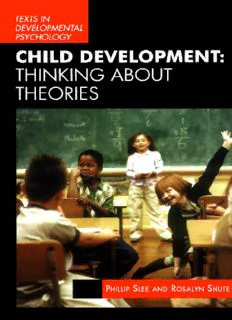
Child Development: Thinking about Theories (Texts in Development Psychology Series) PDF
Preview Child Development: Thinking about Theories (Texts in Development Psychology Series)
Texts in developmental psychology Series Editor: Peter Smith Goldsmiths College, University of London ALSO IN THE TEXTS IN DEVELOPMENTAL PSYCHOLOGY SERIES: THE CHILD AT SCHOOL Peter Blatchford and Anthony Pellegrini ATTACHMENT AND DEVELOPMENT Susan Goldberg FRIENDS AND ENEMIES Barry H. Schneider Child Development: Thinking About Theories Phillip T. Slee School of Education, Flinders University, Adelaide Rosalyn H. Shute School of Psychology, Flinders University, Adelaide First published in Great Britain in 2003 by Arnold, a member of the Hodder Headline Group, 338 Euston Road, London NW1 3BH http://www.arnoldpublishers.cotn Distributed in the United States of America by Oxford University Press Inc. 198 Madison Avenue, New York, NY10016 © 2003 Phillip Slee and Rosalyn Shute All rights reserved. No part of this publication may be reproduced or transmitted in any form or by any means, electronically or mechanically, including photocopying, recording or any information storage or retrieval system, without either prior permission in writing from the publisher or a licence permitting restricted copying. In the United Kingdom such licences are issued by the Copyright Licensing Agency: 90 Tottenham Court Road, London W1POLP. The advice and information in this book are believed to be true and accurate at the date of going to press, but neither the authors nor the publisher can accept any legal responsibility or liability for any errors or omissions. British Library Cataloguing in Publication Data A catalogue record for this book is available from the British Library Library of Congress Cataloging-in-Publication Data A catalog record for this book is available from the Library of Congress ISBN 0340 808179 (hb) ISBN 0340 808187 (pb) 12345 67 89 10 Typeset in 10 and 13pt Plantin by Dorchester Typesetting Group Ltd Printed and bound in Great Britain by MPG Books Ltd, Bodmin, Cornwall What do you think about this book? Or any other Hodder Arnold title? Please send your comments to [email protected] Contents List of figures and tables vii Preface ix 1 Ways of knowing about development 1 2 From Darwin to DNA: biologically based theories of development 26 3 A rainbow is more than the sum of its colours: beginnings of organicism 45 4 The child as philosopher 60 5 From Oedipus to attachment: the Freudian legacy 80 6 Mechanism: the whole is equal to the sum of its parts 97 7 Dialecticism: the child developing in a social world 113 8 The historic event: contextualism 125 9 Sociocultural influences on development 136 10 Listening to different voices: feminism and developmental psychology 151 11 Putting it all together: towards theoretical integration 165 12 From theory into practice 184 Appendix 1: Some historical milestones relevant for developmental psychology 195 Appendix 2: Discussion questions, activities and selected websites 198 Glossary 204 References 208 Index 228 This page intentionally left blank List of figures and tables Figures 1.1 'Images' of children as influenced by history, culture and the philosophy of science 18 3.1 The visual illusion of the Ames window 47 3.2 Examples of developmental tasks 57 6.1 A simplified model of information processing 108 9.1 Maori model of human development 148 Tables 2.1 Evolutionary developmental theory: evolved domains of mind 33 This page intentionally left blank Preface This book is part of a series that addresses a range of theoretical and applied issues in developmental psychology. Our purpose is to provide a broad overview of theories of child development, although practice is certainly not neglected. As well as being academic psychologists, we have strong professional interests: Phillip has a background in teaching, edu- cates student teachers and has produced internationally utilized materials to address school bullying; Rosalyn is an experienced coordinator of professional postgraduate psychology programmes and provides clinical psychology services to young people and their families. Most of our publi- cations address applied issues. At first sight, then, it is perhaps a little curious that a book on theories of child and adolescent development should be written by two people whose primary interests are applied. However, we take a holistic approach to our work, and see theory as underpinning all aspects of it, including research, teaching and profession- al practice. We therefore considered it important to include a chapter on the implications of theory for practice, especially given the primary reader- ship of the book (higher-level undergraduates, honours students and postgraduates), who are at the stage of considering the connections between their undergraduate education and future career plans. We also considered it important to have some empirical basis for decisions about how to structure the book. As well as drawing upon the developmental literature, guidance from the series editor and book proposal referees, and our own experience with writing texts, we held a focus group of honours psychology students at our university to ask them what they would like to see in a book such as this. One of their main issues was that they wanted to gain an overall picture of various theories and how they fitted together, in contrast to the fragmented image they felt they had gained as undergraduates. We have therefore attempted to make some explicit historical and theoretical links between different schools of thought. They also felt that the university culture of critique left them with only a sense of 'what was wrong' with various theoretical approaches, and they also wanted to know 'what was right' with them. They asked to see examples of the implications of theory for practice, which accorded well with our own conception of the book, and reported being put off by too much abstract writing without examples and too many pages of unbroken
